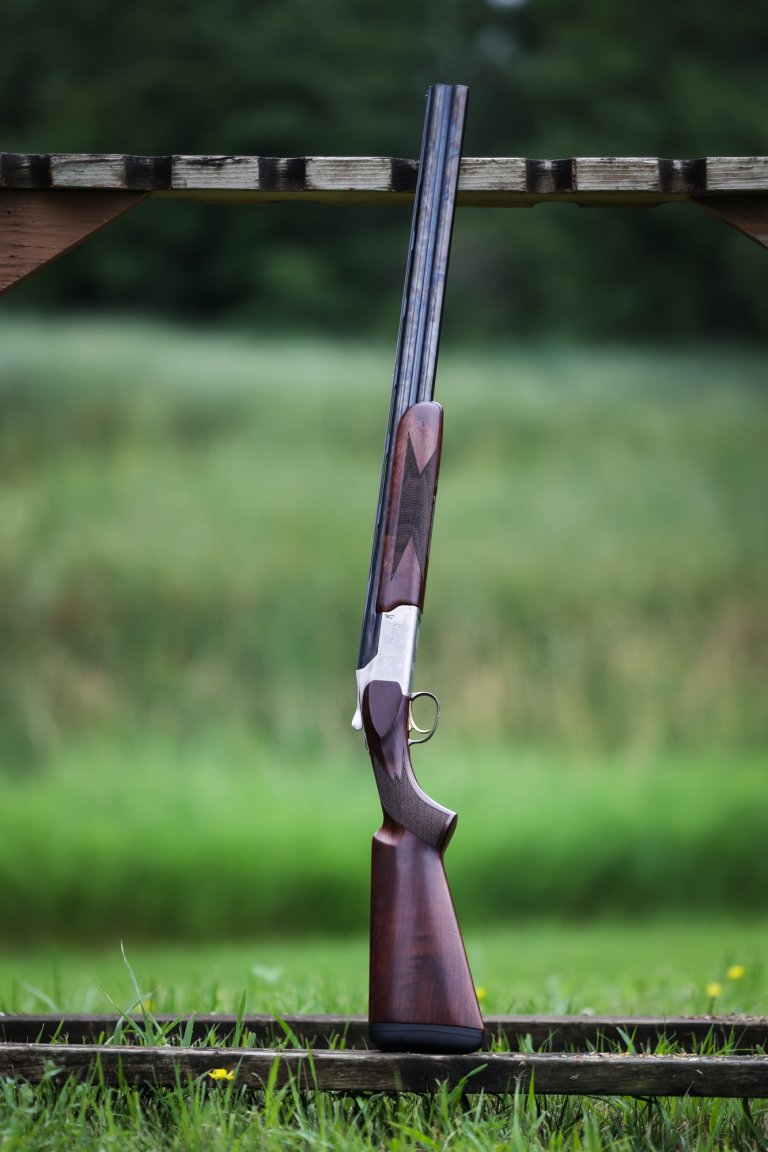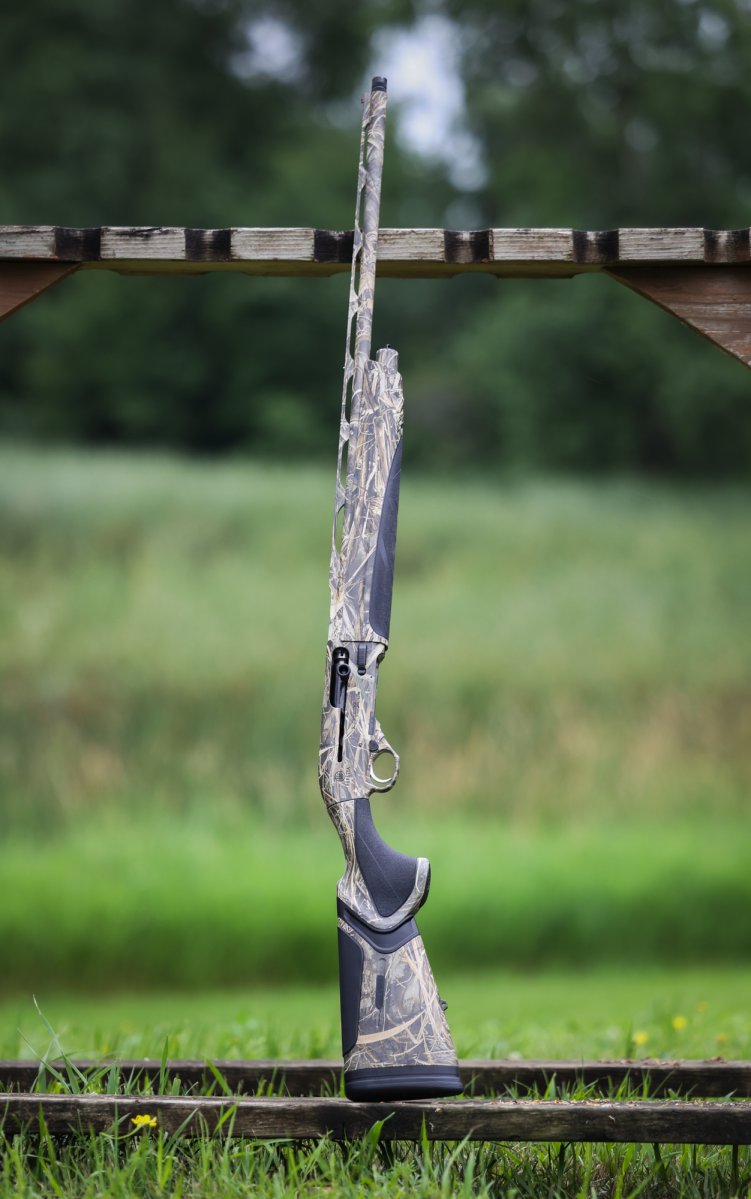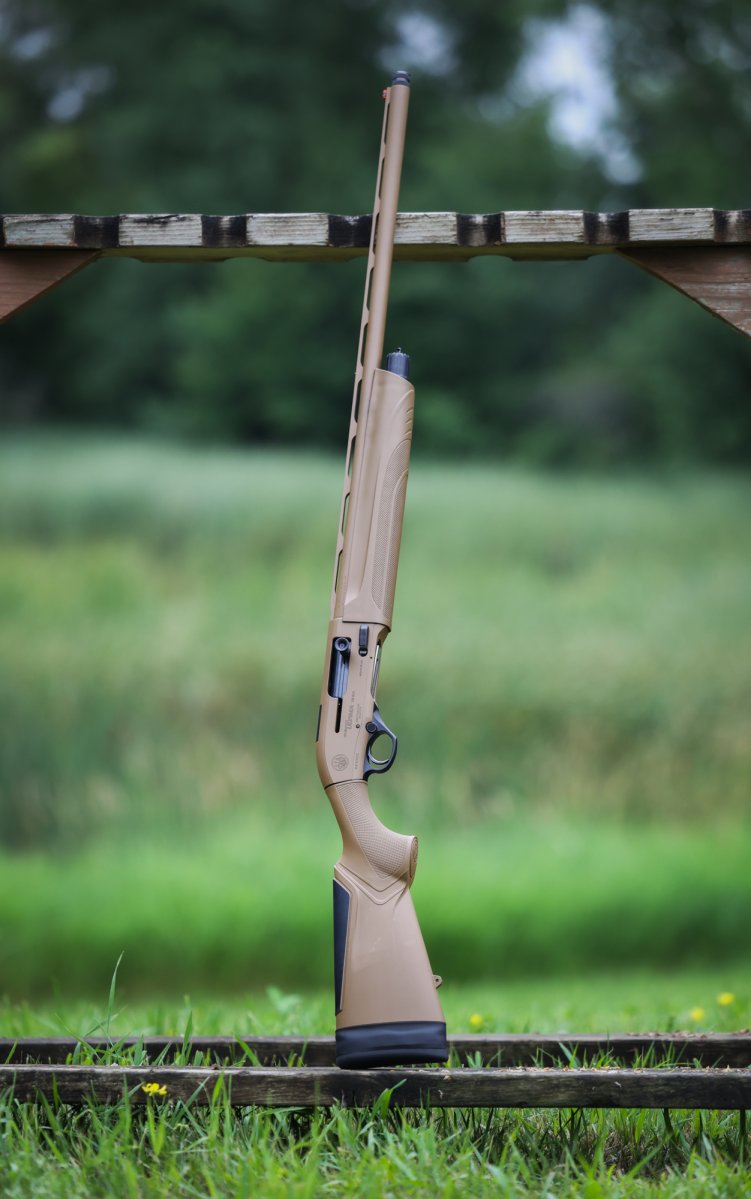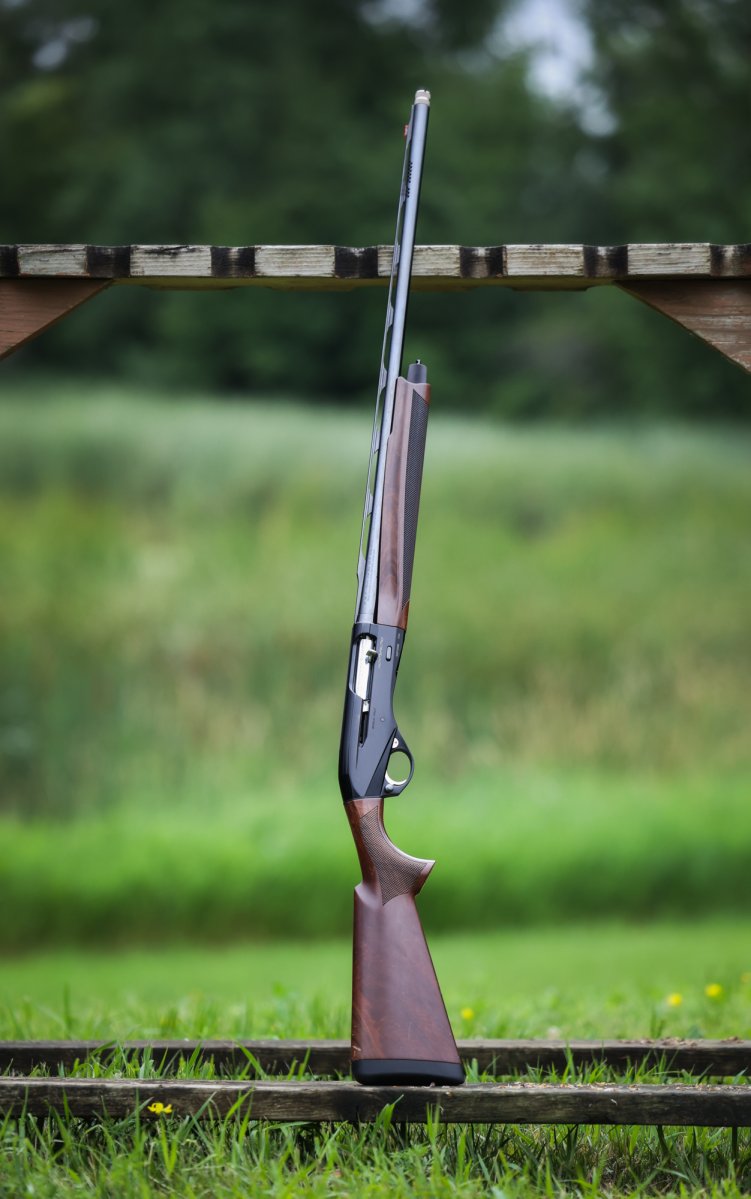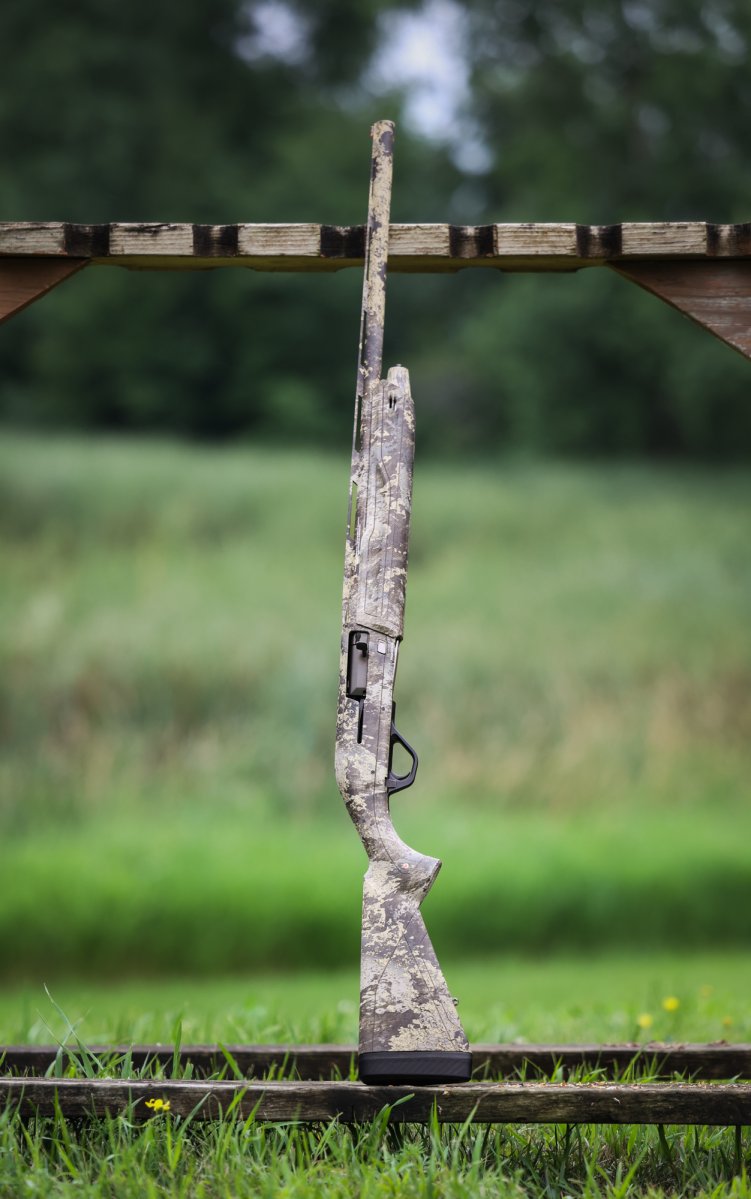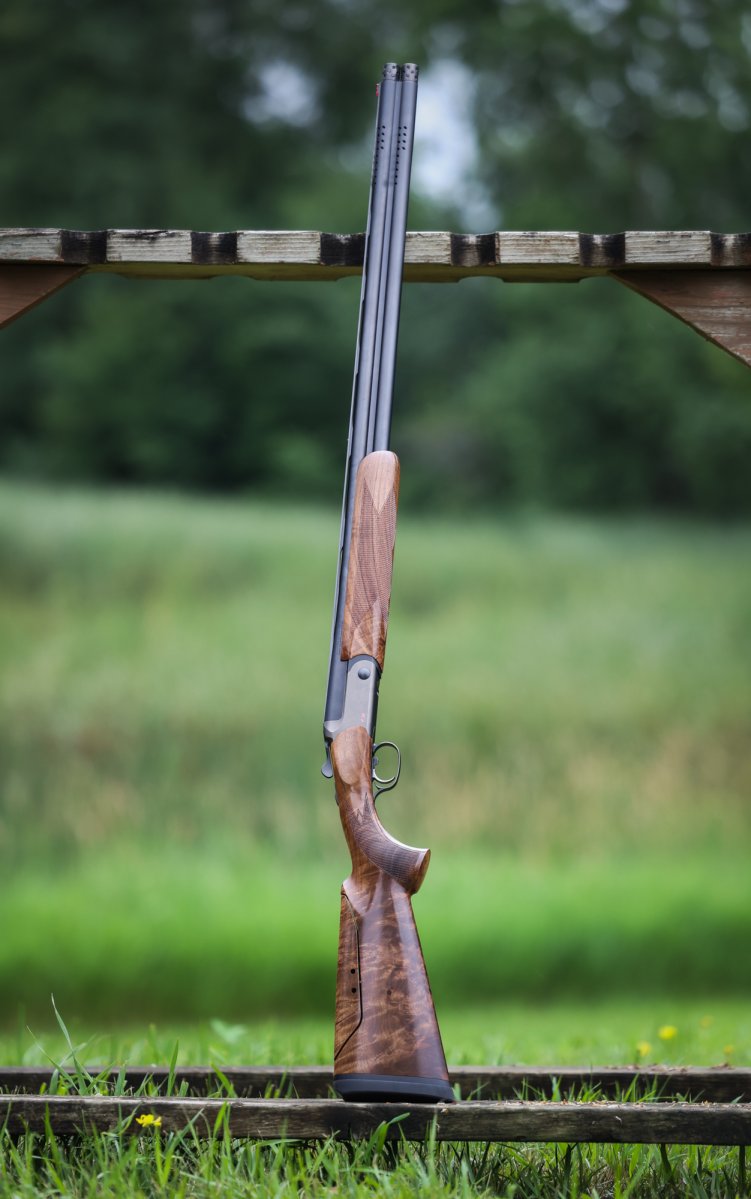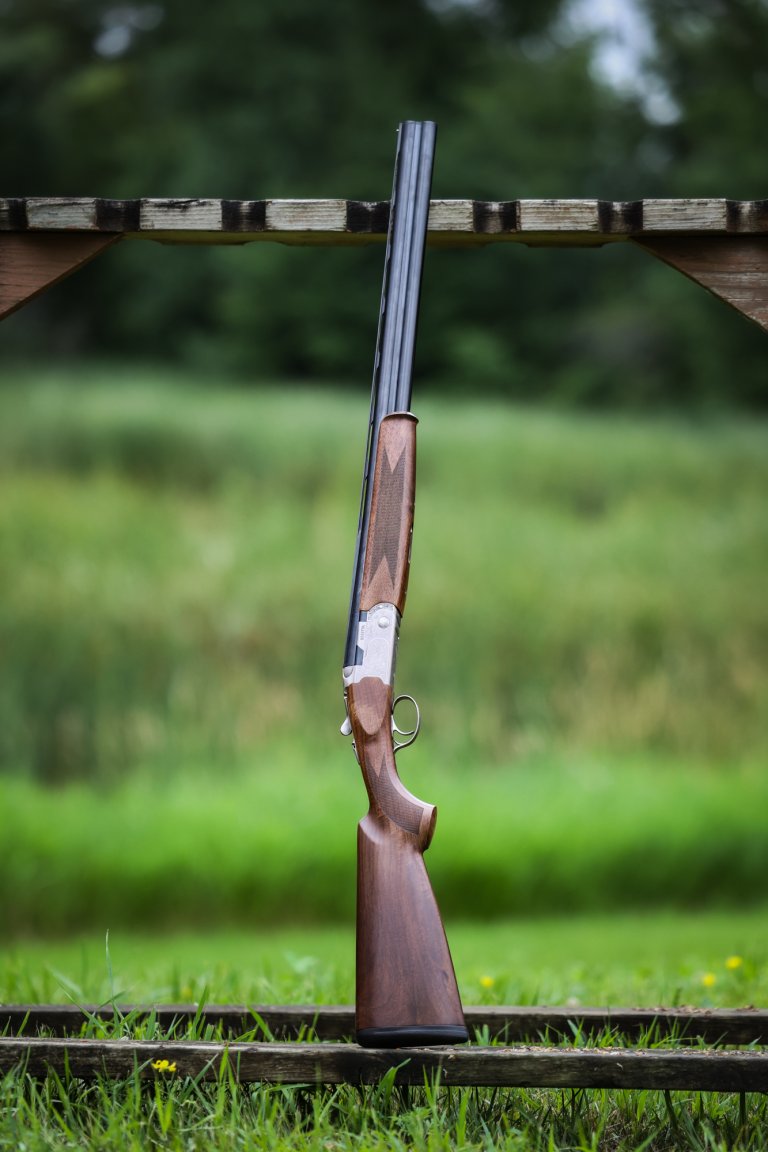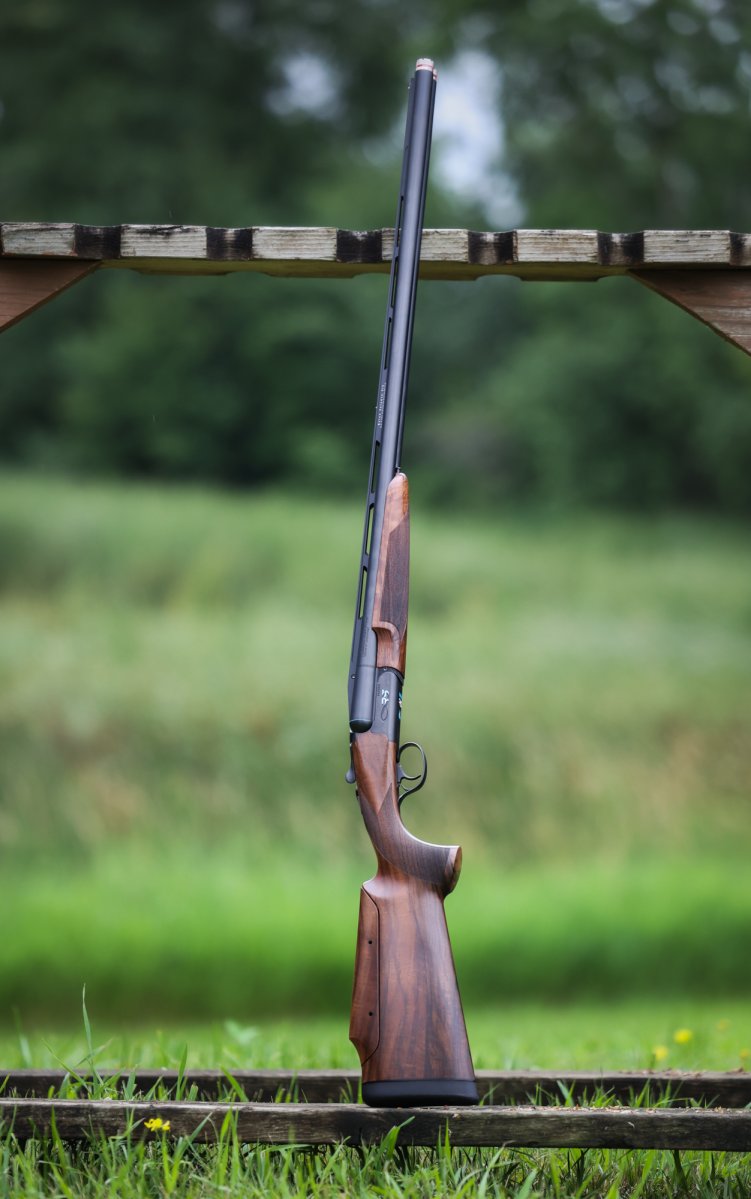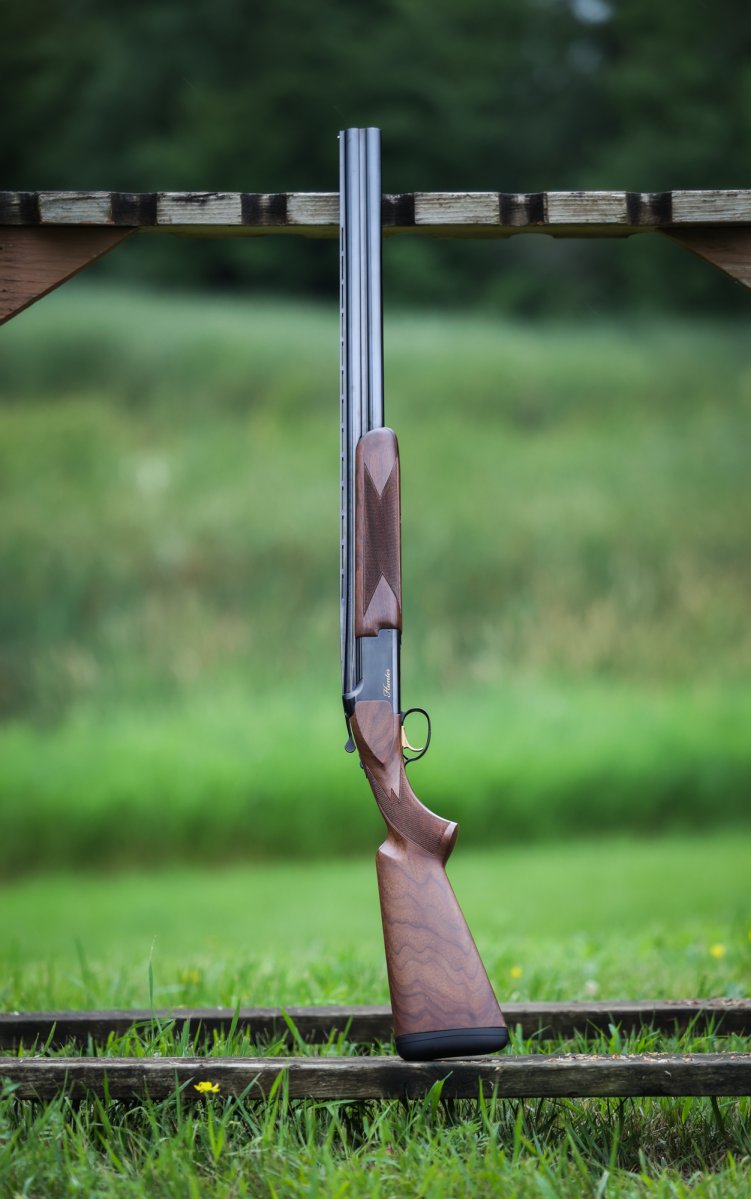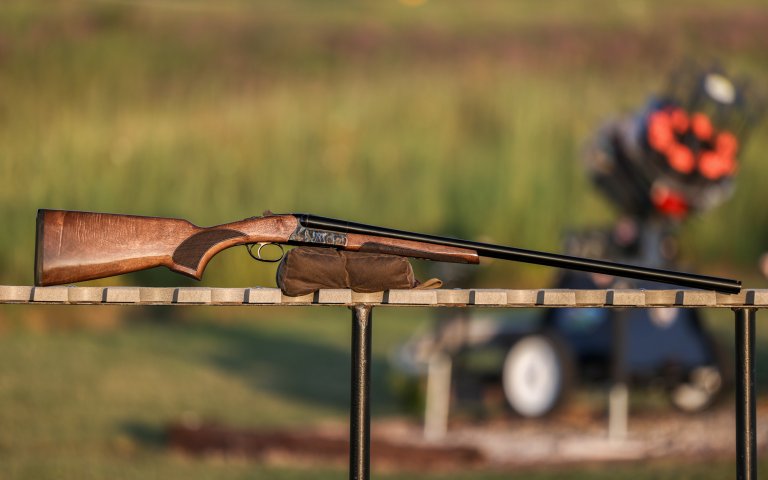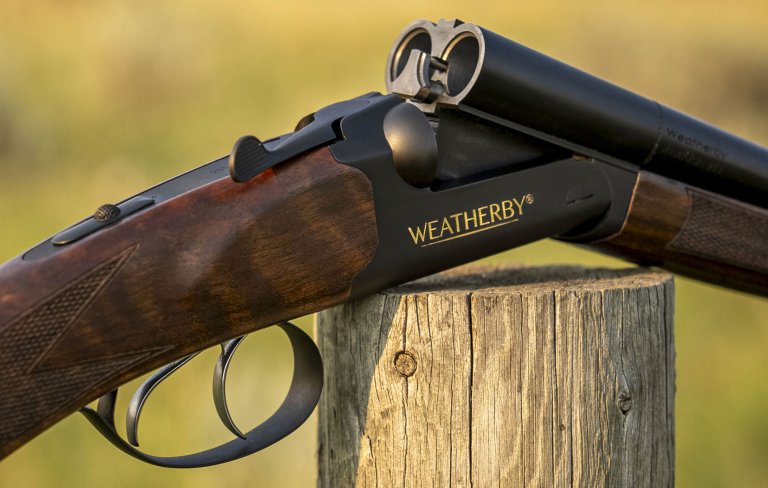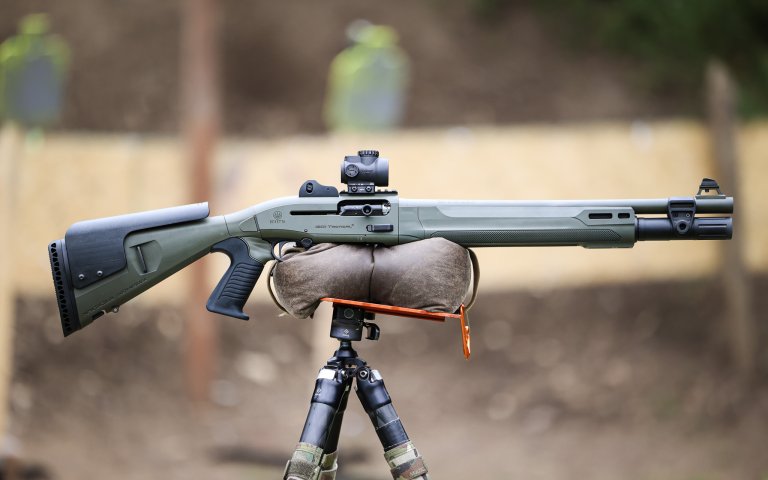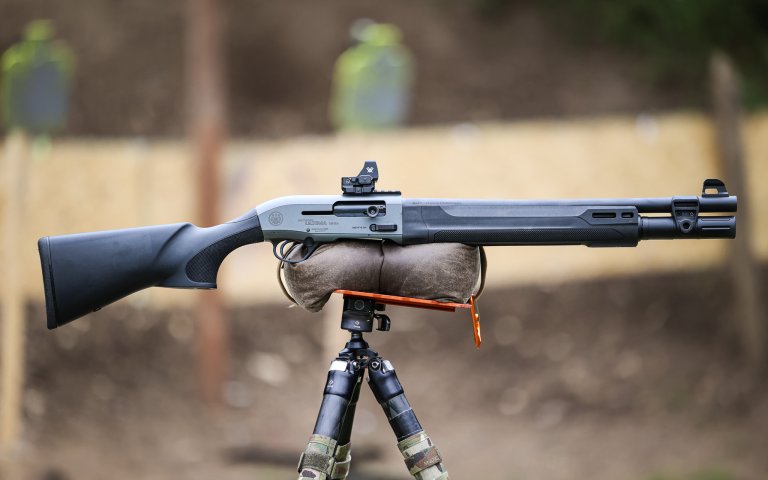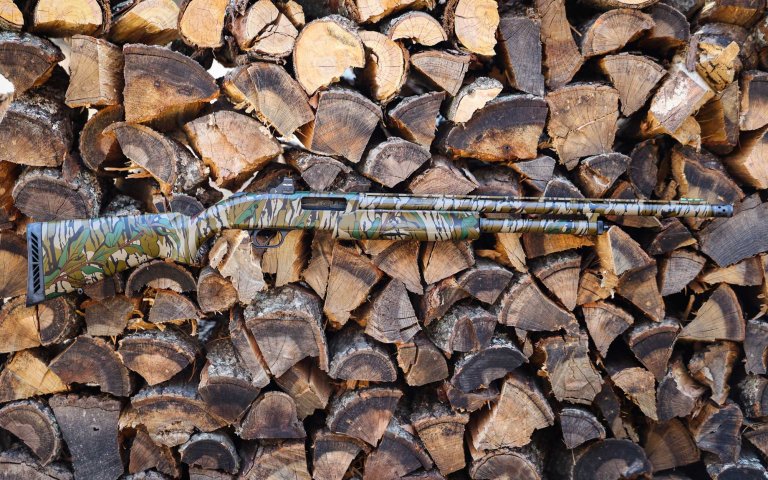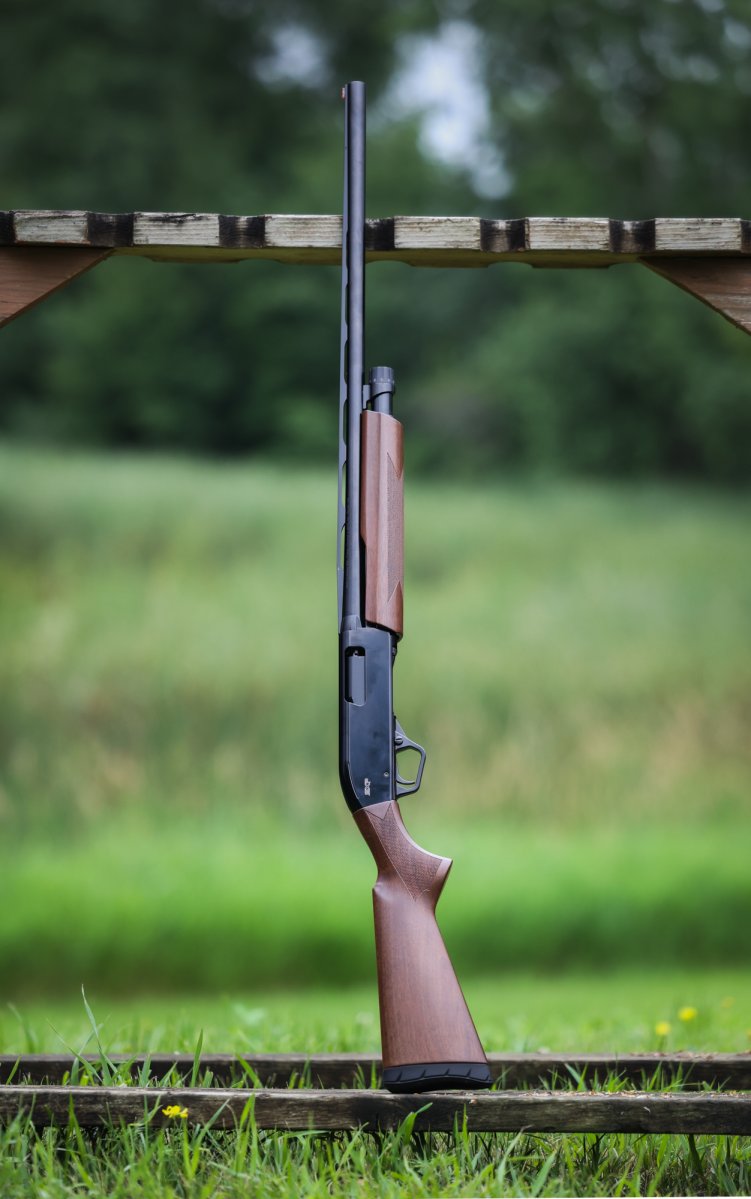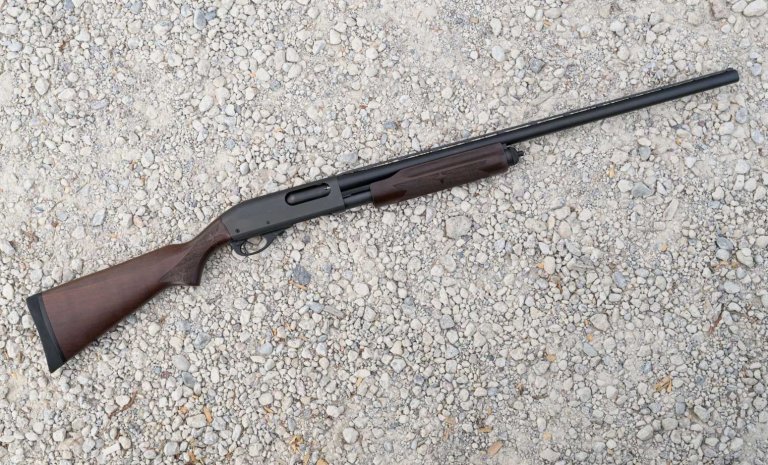We may earn revenue from the products available on this page and participate in affiliate programs. Learn More ›
Each year our field of best shotguns seems to grow. The reason for this is actually quite simple. Gun companies keep adding new and appealing models to their lineups, while maintaining the quality of existing models that have proven their worth over the years – and in some cases over the decades.
The result is a plethora of smoothbores to pick from no matter what you’re looking for. Helping you pick the right shotgun for your needs is one of the main goals of this test — the other being that we’re intensely curious ourselves to find the best bird guns, target guns, and bargain buys for our own shotgunning addictions.
To gather the data presented here we assembled a field of nearly 30 shotguns and spent a week shooting them at the Horse and Hunt Club in Prior Lake, Minnesota. To start, we patterned them all at 12 yards (to test point of impact) then pitted them against each other while busting more clay targets than we could count. The goal was to push each shotgun to its limit and figure out where they shone and where they fell short. We had every type of target at our disposal — skeet, sporting clays, 5-stand, FITASC — and a good flat-range for the tactical shotguns. We even brought our own thrower along — a Caldwell Claycopter — to add more spice to the mix.

We compared this information to the tests we’ve done in the past and, voila, are able to present the most comprehensive shotgun test out there. We’ve culled the field to showcase only the top shotguns, broken down by category.
- Editor’s Choice (Hunting): Browning Citori 825 Field
- Great Buy: Retay ACE
Best Over/Under and Side-by-Side Shotguns
- Blaser F16 Pro (Editor’s Choice, Competition)
- Beretta 686 Silver Pigeon
- Fabarm Infinite RS
- Browning Citori Hunter Grade I
- Tristar Phoenix (Great Buy, Hunting)
- Weatherby Orion
Best Tactical/Defensive Shotguns
- Mossberg 500 Turkey (Editor’s Choice)
- Winchester SXP
- Remington 870 Field Master
Best Shotguns of 2025, Reviews & Recommendations
Browning Citori 825 Field (Editor’s Choice)
Pros
- Sweet shooter
- Fine workmanship
- Attractive lines
Cons
- Expensive
Key Features
- Intended use: Upland bird hunting
- Included chokes: IC, M, F (Invector DS, flush)
- Barrel finish: Polish blued
- Stock: Black walnut, Grade II/III
- New Fire Lite 2 mechanical trigger
- Inflex II recoil pad
- Vector Pro lengthened forcing cones
- Made in Japan
If there’s an over/under with more iterations than the Browning Citori, I can’t think of it. This prolific line expanded once again in 2025 with the introduction of the Model 825, which does honor to the Citori legacy.
The Citori 825 is offered in trap, sporting clays, and field configurations. The 825 Field we tested is geared toward upland bird hunters, a role for which it is admirably suited.

It has nice mechanical triggers, balances well with its 28-inch barrels, and doesn’t bite much thanks to its Inflex 2 recoil pad. At just 7.3 pounds it is light enough for all-day carry — a critical requirement for hunting far-ranging uplands that stretch out to the horizon.
Compared to the Citori 725, another gun we like, it has a modernized look and more elegant and refined components, specifically the top lever and safety/barrel select. The 825’s stock has a softer, more rounded profile, where the 725 lines are more angular and defined. Which looks better is purely a matter of personal taste.
We also liked the 825’s simple adornment, with a grouse on one side and pheasant on the other.

Fans of Browning Citoris are going to love this new model, and hunters who aren’t familiar with them could easily fall under the Browning’s sway if they get a chance to try one out. We were both smitten and impressed by the Citori 825 Field, which is why it earned an Editor’s Choice award as the best shotgun of 2025.
| Citori 825 Field Specs | |
| Gauge | 12 |
| Chamber | 3 inches |
| Action | over/under (mechanical triggers) |
| Weight | 7.3 pounds |
| Trigger | 3 pounds, 5 ounces |
| Barrel | 28 inches |
| Overall Length | 43.75 inches |
| LOP | 14.25 inches |
| Price | $3,320 |
Retay ACE (Great Buy)
Pros
- Excellent value
- Reliable operation
- Versatile
Cons
- Harsh recoil with game loads
Key Features
- Intended use Waterfowl and general bird hunting
- Included chokes Cyl, IC, MOD, IM, F, and extended IM
- Shim kit included
- Barrel Finish Matte black
- Stock: Black composite
- Airy recoil pad
- Made in Turkey

Retay has a smart formula that works. The company makes Benelli clones built in Turkey at attractive prices. The quality of these shotguns — from a purely functional standpoint — has been quite good in our experience. Benelli still makes a better overall gun in terms of fit and finish, aesthetics, and workmanship — but Retay checks all the boxes when it comes to the basics.
The ACE, new for this year, is a solid 3-inch, 12-gauge, inertia gun. Even under the Sauron-like gaze of our test team we couldn’t find fault. The controls are easy to operate and intuitive. The action ran smoothly for us with no glitches. And most importantly, it points and shoots great.

We found it to be incredibly intuitive to use. Granted, all of us are experienced Benelli shooters, but even so we think this gun deserves high marks for its simplicity.

As a do-it-all bird gun few others match it for value. You can take this gun pretty much anywhere birds are hunted and not be handicapped. With that level of versatility and reliability it was an easy pick as this year’s Great Buy.
| Retay ACE Specs | |
| Gauge | 12 |
| Chamber | 3.5 inches |
| Action | semi auto, inertia operated |
| Weight | 7.22 pounds |
| Trigger | 4 pounds, 4 ounces |
| Barrel | 28 inches |
| Overall Length | 49.75 inches |
| LOP | 14.5 inches |
| Price | $1,049 |
Best Semi-Auto Shotguns
Beretta A400 Xtreme Plus
Pros
- Soft-recoiling gas system
- Fine ergonomics
- Points and swings like a charm
Cons
- Nothing of note
Key Features
- Intended use: General bird hunting
- Included chokes: C, IC, M, IM, F, Optima Choke HP extended
- Barrel Finish: Realtree Max 7
- Stock: Synthetic, Realtree Max 7
- Kickoff system for managing recoil
- Shim kit included
- Steelium barrel
- Made in Italy

The Beretta A400 Xtreme Plus ranks as one of our all-time favorite shotguns. It is among the most enjoyable, and easy-to-shoot, shotguns made. It is lightweight and soft-recoiling — qualities that don’t always go together — and is ideal for high-volume bird shooting. But even if a trip to the dove fields of Argentina isn’t in your future, this gun is still worthy of consideration.
The combination of Beretta’s gas-operated action, the recoil reducing Kickoff system in the stock, and the mild-mannered nature of a 20-gauge elevate this gun among similarly priced semis. Without question, it is a shotgun you can bang away with all day with no fear of grinding your shoulder to a pulp.
The shotgun’s ergonomics are excellent. The stock has great texture for a solid grip, the grip angle is comfortable and provides excellent control, and it has generously sized controls for easy operation, even while donning gloves. Beretta’s crossbolt safety is the best of its kind, smooth and positive to operate.
It’s easy to picture this shotgun excelling in a variety of scenarios, but it would make a hell of a duck gun in flooded timber for certain. Any avid bird hunter who enjoys shooting sub-gauges and doesn’t insist on shotguns with two barrels will appreciate this Beretta’s charms.
| Beretta A400 Xtreme Plus Specs | |
| Gauge | 20 |
| Chamber | 3 inches |
| Action | Semi-auto, gas operated |
| Weight | 6.87 pounds |
| Trigger | 4 pounds, 11 ounces |
| Barrel | 28 inches |
| Overall Length | 48.5 inches |
| LOP | 14.5 inches |
| Price | $2,049 |
Beretta A300 Ultima (Great Buy)
Pros
- Tremendous value
- Versatile
- Excellent handling and balance
Cons
- Nothing of note
Key Features
- Intended use: General purpose hunting
- Included chokes: IC, M, F, Mobil extended
- Barrel Finish: Solid marsh
- Stock: Synthetic, solid marsh
- Kickoff system for managing recoil
- Stock spacer kit included
- RMR Footprint red dot mount machined into the receiver
- Made in USA

The Beretta A300 Ultima is a killer value in a mid-priced semi-auto shotgun. It can be found for less than a grand, and for that outlay you get a gun that is reliable, easy to shoot, and versatile.
There isn’t much a 3-inch 12 gauge with a 28-inch barrel can’t do. It is a jack-of-all-trades configuration and the A300 leans into that idea. For instance, it comes with a cutout on the receiver to mount a red dot. This simple procedure converts the A300 into a turkey gun and only takes a couple minutes to do.
But the Ultima’s happy place is flying targets, whether of the feathered or clay variety. We couldn’t get over the fine balance of this gun and its surprisingly nimble handling.
The intangibles of a shotgun’s swing and fit can be highly personal, but the A300 Ultima — like a genial Lab —worked happily for us all, no matter our stature or shooting style.
Compared to shotguns in its peer group, it has the best controls, ergonomics, and fit and finish. The Kickoff system, which dampens felt recoil, is a really nice feature at this price point.
| Beretta A300 Ultima Specs | |
| Gauge | 12 |
| Chamber | 3 inches |
| Action | Semi-auto, gas operated |
| Weight | 7.69 pounds |
| Trigger | 3 pounds, 10 ounces |
| Barrel | 28 inches |
| Overall Length | 48 inches |
| LOP | 14.25 inches |
| Price | $1,089 |
Benelli Montefeltro Ultra Light
Pros
- Light and easy to carry
- Very good ergonomics
Cons
- Whippy swing
Key Features
- Intended use: Upland bird hunting
- Sight: Red bar
- Barrel Finish: Gloss Blued
- Stock Finish: Satin Walnut, Grade A
- Includes: Three Crio Chokes (C, IC, M), shim kit
- Made in Italy

The Montefeltro Ultra Light is a svelte 20-gauge gun that is an ideal autoloader for hunters who chase grouse and woodcock in alder thickets and wild raspberry brambles where swinging a shotgun requires as much luck as technique.
The reason it is so well suited for that task is its 24-inch barrel, which gives the shotgun an overall length of just 45.6 inches. Because it’s so light (5.6 pounds) and compact, the gun has a whippy swing so that takes some getting used to. To a person, the test team longed for one with a 28-inch barrel.
Overall, we had strong, nearly universal, praise for the gun. It loads smoothly and rapidly thanks to the undercut receiver and scalloped ramp on the trigger guard that help guide shells into the magazine.
The controls are all positive and easy to manipulate. The bolt release, carrier/action release, and bolt handle are all conveniently positioned and intuitive to manipulate. The crossbolt safety is stiff to operate and doesn’t have any texture machined into to give positive contact with your finger — but this wasn’t a dealbreaker.
The stock is attractive and trim and feels good in the hand. The pistol grip and fore-end have laser-cut checkering that provides good grip and control, and the carbon-fiber rib contributes to the shotgun’s modern looks.
| Benelli Montefeltro Ultra Light Specs | |
| Gauge | 12 |
| Chamber | 3 inches |
| Action | Semi-auto, inertia |
| Weight | 5.60 pounds (measured) |
| Trigger | 2.31 pounds (measured) |
| Barrel | 24 inches |
| Overall Length | 45.6 inches |
| LOP | 14.38 inches |
| Price | $1,949 |
Winchester SX4
Pros
- Excellent value
- Reliable
- Good handling
Cons
- Plain looks
- Intended use: General purpose hunting
- Included chokes: IC, M, F Invector, flush
- Barrel Finish: True Timber Prairie
- Stock: Synthetic, True Timber Prairie
- Inflex recoil pad
- More than a dozen camo and finish options
- Made in Portugal
The Winchester SX4 has been a perennial pick of ours for its value, and it has been a particular favorite for budget-minded waterfowlers for many years. Whenever we’ve included the SX4 in our panel-scored shotgun tests, shooters have taken to it naturally and shot it well. From a pure performance standpoint, the SX4 is a hell of a bargain. When testing patterns during our review of the best duck guns, the SX4 did the best among the semi-autos in its price bracket.
The SX4 is relatively light and slim for a gas gun, though the aesthetics and finish are rough, even for a sub-$1,000 gun. There are a variety of iterations of the SX4 geared toward upland hunters as well as waterfowlers, including this model here that wears True Timber Prairie camo.
If you want the best deal possible in an SX4, go with the black synthetic version, but if you want something that’ll blend in better (or is just more pleasing to your eye) this one is a fine option.
Either way, the SX4 is a workhorse — solid and well mannered. You can’t go wrong with it.
| Winchester SX4 Specs | |
| Gauge | 12 |
| Chamber | 3.5 inches |
| Action | semi auto, gas operated |
| Weight | 7.1 pounds |
| Trigger | 3 pounds, 12 ounces |
| Barrel | 26 inches |
| Overall Length | 47 inches |
| LOP | 14.25 inches |
| Price | $1,250 |
Best Over/Under and Side-by-Side Shotguns
Blaser F16 Pro (Editor’s Choice, Competition)
Pros
- Fabulous shooter
- Excellent craftsmanship
Cons
- While a good value, it is still spendy
Key Features
- Intended use: Sporting clays competition
- RHINO’s patented 13-port “pigeon porting” system and RHINO G1 series chokes
- Barrel Finish: Matte black
- Stock: Walnut Grade 4
- Blaser EBS ejector system for easy-closing action
- Weight kit to adjust balance
- Adjustable stock
- Kick-EEZ butt pad
- Hard case included
- Made in Germany

When it comes to shooting competitions there’s an old saying: You can’t gear your way into the winner’s circle. And it’s true. Top-of-the-line equipment is no substitute for practice, determination, and skill. But there’s a corollary to this as well: You can’t win an F1 race behind the wheel of a Subaru.
Shooting a Blaser F16 Pro in a sporting clays competition won’t guarantee anything beyond a participation trophy, but you sure as hell will shoot better and tip the odds in your favor of a podium finish if you shoulder one.
This is a purpose-built over and under with one goal in mind — pulverizing clay targets no matter how far away or fast they are traveling. The 32-inch ported barrels and 8.5-pound weight make this the softest shooting double we’ve ever tested, as well as one of the sweetest swinging 12-gauges we’ve shot.

The F16 Pro has a substantial price tag (though in the world of serious competition shotguns it is practically entry-level) but despite that it is a very good value.
The workmanship, lovely wood, easy closing action, slightly muzzle-heavy balance, and crisp triggers translate into a wonderful shooting experience.
All the controls are crisp and precise and are easy to manipulate. The contours of the stock, with its swept competition-style grip, are very well designed, and augment the shotgun’s in-hand balance and surprisingly lively feel.
If you’re an avid clays shooter, but haven’t taken the plunge into the deep (and expensive) end of the sporting shotgun pool, then this over-and-under might be the ticket. Be forewarned, however. Plan on allocating for a substantial ammo budget, because once you start breaking clays with this Blaser you’re not going to want to stop.
| Blaser F16 Pro Specs | |
| Gauge | 12 |
| Chamber | 3 inches |
| Action | Over/under (mechanical triggers) |
| Weight | 8.52 pounds |
| Trigger | 3 pounds, 4 ounces |
| Barrel | 32 inches |
| Overall Length | 49 inches |
| LOP | 14.5 inches |
| Price | $6,675 |
Beretta 686 Silver Pigeon I
Pros
- Quick handling
- Proven design
- Crisp triggers
Cons
- A bit spendy
Key Features
- Intended use: Upland bird hunting
- Included chokes: C, IC, M, IM, F Optima Choke HP
- Barrel Finish: Blued
- Stock: Walnut Grade 2
- Floral laser engravings in receiver
- Adjustable BFast stock
- Steelium barrels have a doubled forcing cones
- Made in Italy
The Beretta 680 series of shotguns has been around since the late 1970s, and the 686 is the shotgun that put Beretta on the map with American shooters when it was introduced in 1994. Until then, Beretta hadn’t marketed a shotgun in the U.S. that represented such a good value in the O/U world — and shooters in the U.S. flocked to it like ducks to flooded corn.
The 686 Silver Pigeon is still a very good value, showcasing excellent ergonomics, responsive controls, great handling, and fine workmanship in light of its price.
Now, there are some shooters who think the early generation 686s are superior to the current crop. And in terms of the hand fitting and quality of engraving they might have a point. But the newer Silver Pigeons handle better in my opinion, and in terms of performance edge out their forebears. In any case, these are quibbles, as the basic architecture of the 686 has remained unchanged for the last 30 years.
Our test sample handled every type of target we threw with great aptitude and, as you’d expect from a bird gun, it was quick to shoulder. The inertia triggers were crisp, and the safety and barrel selector were easy to use. This is a capable bird gun that looks great and is reasonably priced for its category. What more could you ask for?
| Beretta 686 Silver Pigeon I Specs | |
| Gauge | 12 |
| Chamber | 3 inches |
| Action | Over/under (mechanical triggers) |
| Weight | 7.39 pounds |
| Trigger | 3 pounds, 14 ounces |
| Barrel | 28 inches |
| Overall Length | 45.75 inches |
| LOP | 14.5 inches |
| Price | $2,849 |
Fabarm Infinite RS
Pros
- Out-of-the-box design
- Very good shooter
Cons
- Designed for a narrow niche Expensive
Key Features
- Intended use: Competition
- Included chokes: Skeet, IC, M, IM, F (Exis HP, extended)
- Barrel Finish: Satin black
- Stock: Semi-Deluxe Turkish Walnut
- Tribore HP Barrels
- Hard case included
- Tapered aluminum rib
- Adjustable comb
- Pistol grip with palm swell
- Made in Italy
This is the most curious, specialized, and whimsical gun we’ve tested in an age. If you didn’t know what it was for you might think you’re looking at the shotgunning equivalent of a platypus. Side-by-side barrels, a raised target rib, over-and-under competition style stock, and bright blue highlights are a combination of features never imagined by the makers of London Best shotguns.
However, if you’re a SxS fancier and like to compete in shotgun sports, you might think you’ve stumbled across the Holy Grail.
You’d have to turn the clock back a century to witness a time when side-by-sides dominated target sports. The arrival of over-and-unders during the Great Depression and their advantages — a less cluttered sighting plane and recoil that drives the gun straight back — turned the tide against side-by-sides.
But there has been a persistent coterie of shooters who participate in side-by-side divisions or SxS-only events and Fabarm designed the Infinite RS for them.
With its high target rib and hefty, substantial butt, the Infinite RS handles much like an O/U, and if you’ve ever struggled to connect on targets with a SxS, I can practically guarantee you’ll do better with this shotgun.
The grip orients the hand nearly vertically and gives excellent control over the swing. This shotgun recoils like a side-by-side, with each discharge pushing the gun away from the fired barrel, but the effect is more muted than you’d experience with a traditional double.
If you brought one to your next SxS competition, you’d probably get some dirty looks from the purists who’d see you as a gamer. And they wouldn’t be wrong. The Infinite RS is a side-by-side cheat code. But the last laugh will be yours as you (hopefully) blaze your way to victory over those snooty Luddites with their antiquated Model 21s and other vintage smoothbores.
| Fabarm Infinite RS Specs | |
| Gauge | 12 |
| Chamber | 3 inches |
| Action | SXS, inertia triggers |
| Weight | 8.39 pounds |
| Trigger | 4 pounds, 9 ounces |
| Barrel | 30 inches |
| Overall Length | 49 inches |
| LOP | 14.87 (adjustable) inches |
| Price | $5,495 |
Browning Citori Hunter Grade I
Pros
- Excellent value at its price point
- Points and swings well
- Robust and reliable
Cons
- Bare bones aesthetics
Key Features
- Intended use: Upland hunting
- Included Chokes: IC, M, F, Invector flush
- Barrel Finish: Polish Blued
- Stock: American Walnut Grade I
- Back-Bored Technology
- Vector Pro Lengthened Forcing Cone
- Inflex Recoil Pad II
- Made in Japan
The Browning Citori Hunter Grade I has been part of the Citori lineup from day one back in 1974. It has been serving hunters well for over half a century now and shows no sign of letting up.
The reason for this shotgun’s longevity is that it is offered at a generally attainable price, positioned between entry-level O/Us at $1,500 or less, and fancier stuff costing $2,800 and more. So, for a hunter on a budget aspiring to an O/U with some refinement it is a natural choice. It’s also a smart option for the well-healed sportsman who doesn’t want to subject a fine gun with fancy wood and engraving to rough conditions.
The Citori Hunter handles nicely. It is well balanced with great controls and is easy to run. We never felt like we were fighting anything to bring it into play. For a field gun it hits clays with pleasing authority.
It also has a simple and understated aesthetic that we like. It has a dark stained walnut stock, polished bluing on the barrels, and a dark receiver with a touch of gold lettering and accents.
The sample we just tested had sharp checkering and a barrel selector that moved easily from one setting to the other. It is noticeably bulkier than the Citori 825 Field, but that’s to be expected given their different levels of refinement.
Overall, this is an excellent shotgun for hunters who expect good performance but ultimately prefer to spend their money to go hunting rather than on a fancier gun.
| Browning Citori Hunter Grade I Specs | |
| Gauge | 12 |
| Chamber | 3 inches |
| Action | Over/under (inertia triggers) |
| Weight | 7.54 pounds |
| Trigger | 3 pounds, 3 ounces |
| Barrel | 28 inches |
| Overall Length | 45 inches |
| LOP | 14.25 inches |
| Price | $2,350 |
Tristar Phoenix (Great Buy, Hunting)
Pros
- Inexpensive
- Classic lines
Cons
- Mushy controls
- Patterned to the left
Key Features
- Intended use: Upland hunting
- Includes: SK, IC, M, IM, F flush chokes
- Sight: Silver bead
- Barrel Finish: Blued, gloss
- Stock: Turkish walnut
- Made in Turkey
The Tristar Phoenix was one of the bigger surprises when we first tested it. It is a budget-oriented gun, costing only $795, which means it lacks some of the refinements associated with high-dollar doubles (it can be found online for as low as $705). But Tristar made the most with what its gunmakers had to work with, and the Phoenix offers an aspiring aristocrat a compelling package.
The Turkish-made shotgun has a case-hardened finish on the receiver, high-gloss barrels with flush mounted screw-in chokes, a traditional scalloped sighting rib tipped with a plain brass bead front sight, a tang safety with barrel selectors, gold trigger, and trim fore-end.
The walnut stock isn’t fancy, but is fairly attractive, though the wood on our sample had a slightly gray hue. The checkering is basic too, with an oval pattern on the fore-end that wraps up each side, and two panels on either side of the pistol grip.
In terms of performance, a couple of the shooters on the test shot it as though they were, in Shakespeare’s words, to the manor born. I, on the other hand, have always struggled with side-by-sides, and couldn’t hit the broad side of a pterodactyl with it.
The only shortcomings of the Phoenix were that the left barrel shot to the left at the patterning board (the center of the pattern was about 5 inches left of point of aim) and the safety, which doubles as the barrel selector, was mushy and imprecise. For the price, however, these are acceptable sins.
| Tristar Phoenix Specs | |
| Gauge | 20 |
| Chamber | 3 inches |
| Action | Break action, side-by-side |
| Weight | 6.84 pounds (measured) |
| Trigger | 3.43 pounds (measured) |
| Barrel | 28 inches |
| Overall Length | 45.5 inches |
| LOP | 14.25 inches |
| Price | $795 |
Weatherby Orion
Pros
- Decent wood
- Durable design
- Classic styling
- Excellent value
Cons
- Forgettable cosmetics
- Safety hard to deploy with gloves
Key Features
- Intended use: Upland hunting
- Included Chokes: IC, M, F, ICM flush
- Barrel Finish: Polish Blued
- Stock: Turkish walnut, Grade A
- Automatic ejectors
- Single brass bead
- Made in Turkey
This is another price-point side-by-side that represents a good value as long as you’re clear-eyed about what you’re getting. Hunting editor Andrew McKean did an in-depth review of the Orion after spending a season chasing birds with it in Montana, and I suggest you look at that if you’re pondering a purchase.
His informed take mirrored that of the gun test crew: The Orion offers a ton of versatility and value in a classically styled side-by-side that is built for years of hard hunting and can digest a wide variety of payloads. The action is strong and simple, the wood is honest, and the craftsmanship is a notch above what you’d expect for a sub-$1,000 side-by-side.
That said, it isn’t a smooth or elegant shooter. The recoil is stiff and it isn’t as lively or well-balanced its more costly peers. It won’t win any beauty contests but it will knock down birds, which is the main point after all. The controls aren’t particularly smooth — it had a heavy, tough trigger and safety/barrel selector was sticky — but those drawbacks are understandable, and overshadowed, by this double’s sub-$1,000 (street price) cost.
| Weatherby Orion Specs | |
| Gauge | 12 |
| Chamber | 3 inches |
| Action | Over/under (mechanical triggers) |
| Weight | 6 pounds, 10 ounces |
| Trigger | 3.43 pounds (measured) |
| Barrel | 28 inches |
| Overall Length | 45.5 inches |
| LOP | 14.5 inches |
| Price | $1,199 |
Best Tactical/Defensive Shotguns
Beretta 1301 Tactical C
Pros
- Blazing fast action
- Soft shooting
- Great feature set
Cons
- Nothing of note
Key Features
- Intended use: Tactical and personal protection
- Included chokes: C Optima Choke HP
- Barrel Finish: OD Green
- Stock: Synthetic (OD Green)
- Pic rail included
- Ghost ring sights
- M-Lok in forend
- Adjustable comb
- Capacity: 7+1
- Made in Italy

The Beretta 1301 series is top dog in today’s tactical shotgun market. The feature set, quality of construction, shootability, and reliability is second-to-none. The 1301 Mod 2, which we tested last year, ran away with the Editor’s Choice award. This version, the Tactical C, has the same bones but swaps the folding stock by Chisel Machine for the fixed stock and there’s a version that has capacity knocked back to 5+1 (however the one we tested had a 7+1 capacity).
We ran this gun hard during the test, and it confirmed that our enthusiasm for the platform isn’t misplaced. It cycles wickedly fast and manages recoil like a champ. The well-shaped stock, with its aggressive texturing, helps you maintain control even during enthusiastic mag dumps.
The gun comes with sturdy and effective ghost-ring sights, has M-Lok slot on the fore-end to mount accessories, and an adjustable comb to tune cheek piece height. With its 18.5-inch barrel, the shotgun is maneuverable. For the heck of it, I ran it on flying clays where it held its own, but its sweet spot is on a flat range smacking steel and punching paper.
It is a confidence-boosting gun that is fun to shoot and is a great option for home defense, competition, and general training. Read our full review of the best shotguns for home defense.
| Beretta 1301 Tactical C Specs | |
| Gauge | 12 |
| Chamber | 3 inches |
| Action | Semi-auto, gas operated |
| Weight | 7.28 pounds |
| Trigger | 4 pounds, 5 ounces |
| Barrel | 18.5 inches |
| Overall Length | 37 inches |
| LOP | 12.5 inches |
| Price | $1,999 |
Beretta A300 Patrol (Great Buy)
Pros
- Excellent value
- Good feature set
- Easy to shoot fast and under control
Cons
- Nothing of note
Key Features
- Intended use: Tactical and personal protection
- Included chokes: IC (Mobil system)
- Barrel Finish: Matte black
- Stock: Synthetic (black)
- Included ghost ring sight
- 7-slot Picatinny rail
- 3 M-Lok mounting points and 3 QD sling mounting points
- Includes stock spacer kit
- 7+1 capacity
- Made in USA

The A300 Patrol is the 1301 Tactical’s baby brother at a more attainable price (the main difference is the 1301 has a rotating bolt head and Beretta’s B-Link operating system, which is to say it’s faster and softer shooting). The A300 has all the features one wants in a tactical shotgun and, provided you clean it from time to time, will give many years of reliable service.
The Patrol comes ready to accessorize with its 7-slot Picatinny rail on the receiver — though the included ghost-ring peep sights are very capable — and multiple M-Lok slots on the fore-end and on the barrel clamp — which also has QD cups to clip in a sling.
We really like the Patrol’s ergonomics. Over-sized controls and large loading port let you run the gun even with gloves on. The cross-bolt safety on the front of the trigger guard is one of our favorite designs.
Another thing we like about the Patrol is that, like other A300s, it is made in the U.S., which keeps costs down relative to Berettas made in Italy.
| Beretta A300 Patrol Specs | |
| Gauge | 12 |
| Chamber | 3 inches |
| Action | Semi-auto, gas operated |
| Weight | 6.8 pounds |
| Trigger | 3 pounds, 9 ounces |
| Barrel | 19.1 inches |
| Overall Length | 38 inches |
| LOP | 13 inches |
| Price | $1,149 |
Mossberg 940 Pro Tactical Thunder Ranch (Great Buy)
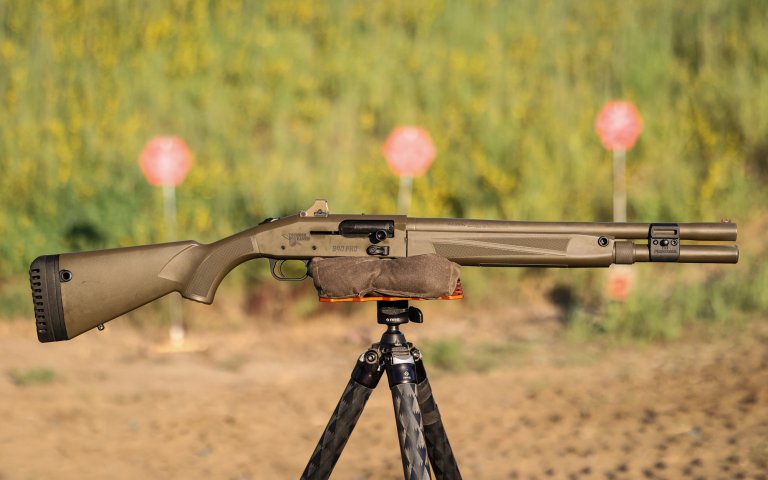
Pros
- Great value
- Reliable platform
- Smart feature set
Cons
- Nothing of note
- Intended use: Tactical and personal protection
- Sight: Red bar, optics ready receiver cut
- Barrel Finish: Cerakote
- Stock: Synthetic, patriot brown
- Includes: Fixed cylinder choke
- Capacity 7 +1

The Mossberg 940 series has been very successful since it debuted in 2020, with multiple variants for competition, hunting, and personal protection in the lineup.
This model is a collaboration with Thunder Ranch, the renowned training facility that was launched by legendary instructor Clint Smith.
Smith’s no-nonsense approach to defensive firearms and training is evident in the 940 Pro Tactical Thunder Ranch. It is configured with what’s needed but no more. Take for example its fixed cylinder choke. While nearly all other new shotguns come with variable chokes, even tactical models, Smith rightly recognizes that they are unnecessary for defensive work and just one more thing to go wrong.
But what it does have is a simple bead for sighting with an optics cut in the receiver if you want to mount a red dot. It has an oversized charging handle, bolt release, and tang-mounted safety for klutz-proof operation under stress, and a basic barrel clamp with M-Lok slots for a light.
During our evaluation we had no issue keeping the red dot on our target during drills with lots of transitions and while shooting quickly. The word that kept cropping up to describe the action was “snappy” and we never felt like we were in danger of outrunning the gun. It is super fast.

From a patterning and accuracy standpoint, the 940 was an overachiever. It recorded our tightest slug group of the test, putting 10 Remington slugger loads within a 1.149-inch group at 25 yards. With Hornady Critical Defense buckshot loads it put all pellets inside the A Zone at 7 yards and 15 yards. At 25 yards it put all pellets inside the A Zone and C Zone.
One interesting refinement is the cocking indicator on the inside of the trigger guard, which is a feature on other 940s as well. This allows you to ascertain the status of the gun in the dark by pressing the back of your trigger finger against the front of the trigger guard to feel for the protruding bit of metal that indicates that the action is cocked.
| Mossberg 940 Pro Tactical Thunder Ranch Specs | |
| Gauge | 12 |
| Chamber | 3 inches |
| Action | Semi-auto, gas operated |
| Weight | 7.5 pounds (measured) |
| Trigger | 2.68 pounds (measured) |
| Barrel | 18.5 inches |
| Overall Length | 37 inches |
| LOP | 12.5 to 14.25 inches |
| Price | $1,295 |
Best Pump-Action Shotguns
Mossberg 500 Turkey (Editor’s Choice)
Pros
- Long history of reliability
- Ambidextrous safety
- Optics ready
- Affordable
Cons
- Heavy recoil
- Has a plastic exterior feel
- Receiver is cut for an RMSc footprint red dot
- Tang-mounted safety
- Ulti Full Choke
- 22-inch barrel
- Weight: 6.75 pounds
- Overall Length: 44.75 inches
- Mossy Oak Greenleaf camo
- Made in USA
I’ve hunted turkeys with Mossberg shotguns for decades and what I love most about them is that they cycle consistently and always go bang when I squeeze the trigger. A beater 500 will get splashed with snow, rain, mud, and turkey blood every season and just keeps running.
The 500 Turkey (available in 20 gauge and .410) feature all the reliability and accuracy of the previous models while also sporting an optic-ready receiver.
Thanks to an ingenious design from Mossberg, its receiver has a little cut-out that fits any red dot sight with a RMSc footprint. Mossberg even offers a combo version of this gun with a Holosun sight installed. The result of this design is that the optic is mounted low on the gun allowing you to make a solid cheek weld on the stock. It also makes for a slim rig. As far as out-of-the box turkey setups go, you won’t do better than this one. Considering you can get the package for about $700, it’s a heck of a deal.
While the OL team has experienced solid field performance with all the Mossberg models, they aren’t always the tightest patterning turkey guns out there. If you intend to shoot at longer distances (beyond 40 yards), it’s a good idea to invest in an aftermarket turkey choke, TSS loads, and do thorough pattern testing. —Alex Robinson
Winchester SXP High Grade Field
Pros
- Affordable
- Reliable
- Cycles fast
Cons
- Gritty controls
Key Features
- Intended use: Hunting
- Included Chokes: IC, M, F, Invector Plus flush
- Barrel Finish: Black gloss
- Stock: Turkish walnut
- Aluminum alloy receiver
- Inflex recoil pad
- Made in Turkey
The Winchester SXP is a workhorse pump-action that has made its mark for its affordability and rugged construction. The 3.5-inch synthetic model is one we’ve recommended for budget-minded waterfowlers. Though a bit a rough cob with respect to its gritty controls, it’ll get the job done and you won’t feel guilty subjecting it to abusive conditions.
The High Grade Field is a more refined and attractive version. It has the same fast-cycling rotary bolt system but comes packaged in a better balanced 3-inch chambering. Its 28-inch barrels and 7-pound weight make it a brisk-handling gun, and there’s little question that the walnut stock and glossy blue barrel are much easier on the eyes.
It comes with three Invector Plus flush choke tubes, so you can dial it in for a variety of hunting and shooting tasks and has a decent butt pad to take the thump out of the recoil.
It is also available in a 20-gauge version, and it’s worth noting that in either chambering you can select from 26- or 28-inch barrels.
| Winchester SXP High Grade Field Specs | |
| Gauge | 12 |
| Chamber | 3 inches |
| Action | Pump |
| Weight | 7.7.4 pounds |
| Trigger | 7 pounds, 1 ounce |
| Barrel | 28 inches |
| Overall Length | 48.5 inches |
| LOP | 14 inches |
| Price | $600 |
Remington 870 Fieldmaster
Pros
- Reliable
- Good value
Cons
- Uncertain availability
When Remington was auctioned off after multiple bankruptcies it was split into two factions. Remington ammunition, part of the same group that owns Federal Premium, and RemArms, which is the firearms manufacturing part of the business.
While the ammo business is chugging along just fine, the gun-making side — now headquartered in LaGrange, Georgia — is gasping like a fish on a dock.
The one product they had been shipping in any quantity was their Model 870 Fieldmaster.
This replaced the 870 Express, one of the most ubiquitous shotguns ever produced, and we liked what we saw. The walnut stock and more corrosion-resistant metal finishes were upgrades over the Express — and it was still offered at a reasonable price.
We’d still recommend this shotgun now for anyone looking for a new pump-action — assuming you can find one. It seems the supply has dried up and we could only locate Fieldmasters in a synthetic stock trim for sale online, and precious few of those. If this changes — for better or worse — we’ll update this entry.
| Remington 870 Fieldmaster Specs | |
| Gauge | 12 |
| Chamber | 3 inches |
| Action | Pump |
| Weight | 8.0 pounds (measured) |
| Trigger | 3 pounds, 12 ounces (measured) |
| Barrel | 28 inches |
| Overall Length | 48.75 inches |
| LOP | 14 inches |
| Price | $800 |
How We Test and Grade Shotguns

As always, we tested the guns by putting them in the hands of capable and unbiased shooters. This year the test team included editor-in-chief Alex Robinson, executive editor Natalie Krebs, and yours truly.
During our week at the Minnesota Horse and Hunt club, which has we burned up thousands of rounds shooting 5-stand, sporting clays, FITASC, as well as throwing targets with the Caldwell Claycopter. We shot the tactical guns on a square range, running a variety of drills with target loads, buckshot, and slugs.
We also banged away at a patterning board to see if the guns point straight, and to figure out the general distribution of their shot.

Each shotgun is evaluated on eight categories scored by each judge: handling, workmanship, aesthetics, ergonomics, meets purpose, versatility, reliability, and value. These scores determine the ranking and awards.
In our grading system, handling, ergonomics, and reliability measure a shotgun’s performance, while workmanship, aesthetics, meeting its purpose, and versatility represent a shotgun’s design. In addition to performance and design we place a lot of emphasis on value, as we’re always seeking the most bang for the buck.

Final Thoughts on the Best Shotguns of 2025
I kicked off this story mentioning the growing field of good shotguns we have to pick among, and with respect to semi-autos and double guns that is true. However, the pump-action market is languishing. You can still find pumps out there, but the selection is thin gruel compared to 10 years ago. Remington is spiraling, Ithaca Model 37s seem perennially out of stock, and Browning discontinued the BPS.
On a happier note, however, we’re seeing innovation and value elsewhere. Optics cuts on receivers let us mount red dots closer to the bore, which lets us keep our head on the stock where it belongs. Stock geometry and design has improved, and when coupled with recoil reducing features this allows for better, and more comfortable, shooting.
And no matter your budget, you can find a shotgun that is somewhere between serviceable and outstanding. It truly is a buyer’s market.

